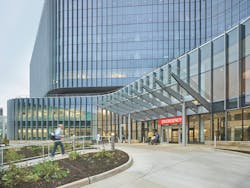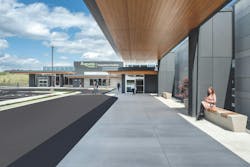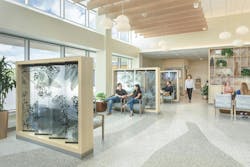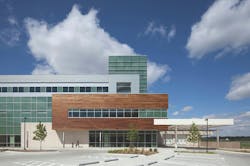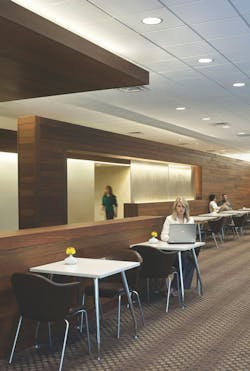U.S. healthcare building sector trends and innovations for 2024-2025
As new medicines, treatment regimens, and clinical protocols radically alter the medical world, facilities and building environments in which they take form are similarly evolving rapidly. Innovations and trends related to products, materials, assemblies, and building systems for the U.S. healthcare building sector have opened new avenues for better care delivery. Discussions with leading healthcare architecture, engineering, and construction (AEC) firms and owners-operators offer insights into some of the most promising directions.
While larger hospitals tend to dominate the news when it comes to healthcare AEC trends, a study by McKinsey last year noted that ambulatory care comprises about 30% of total provider revenues—and trending upward. Medical buildings account for over 40% of all healthcare construction. Many of the most nimble and adaptable segments of the healthcare world today are smaller outpatient facilities and clinics, medical office buildings (MOBs), specialty facilities such as radiology and physical therapy buildings, as well as the proliferation of urgent care centers nationally.
As of last year, at least 300 urgent care facilities—many of them multibuilding complexes, and some with structured parking—were added in the United States, bringing the number of standalone operations to well over 6,000 total. Thousands of freestanding and lessee clinics were added nationally also. Some of these smaller satellite developments are templated rollouts, similar to retail franchises.
“We also see a recurring initiative in which our healthcare clients evaluate and execute standardization across their facility programs,” says Walter Jones, Senior Director and Healthcare Market Leader for Barton Malow. “These initiatives include developing prototypic model approaches, from the component room or building system standards to entire facility design and delivery prototypes.” An example of this approach, he explains, is seen in freestanding emergency department (FSED) facilities.
The expansionary trends in smaller clinics and urgent services facilities in a greater range of locations suggest not just wider access to care but also more kinds of specialization to make delivery more efficient, targeted, and robust. “Healthcare is becoming omnipresent and will exist ‘without walls,’” says Don Rosën, a Boston-based Principal with the global consulting and engineering firm Buro Happold. “In addition to healthcare campuses, we are seeing ambulatory surgery, cancer treatment centers, medical office buildings, and acute-care facilities to try and decentralize healthcare services from the main campuses.”
Identifying a need for wider access to care, many health providers have expanded their operations in ways that support all area residents, not just the insured or well-off. “We are working on healthcare facilities that address the wellness of marginalized populations, in other words, facilities supporting the mental and physical wellbeing of those who are homeless or unable to afford care otherwise—or both,” says Doug Lovegren, AIA, a Partner with architecture and art firm Svigals + Partners.
“We approach these designs the same way we do any healthcare facility, which is to provide a dignified environment to deliver the highest quality of care,” says Lovegren, who has worked with design teams on dozens of projects, from reconstruction and retrofit to entire health and education campuses. “We are also learning more and more about trauma-informed design and how it can benefit the patients and improve outcomes.”
According to Elisandra Garcia, Director of Engagement with architecture, urban planning, and fabrication firm El Dorado, trauma-informed design is being applied to installations, landscapes, and entire health centers and districts. “Project teams start early in determining how their work can support healing for young people or families—even neighborhoods—coping with scarring from the ordeals of addiction, for example, or the unintended effects of justice and welfare systems,” says Garcia, who is a bilingual expert in environmental and spatial justice. “There is a growing awareness of the importance of wellness, including recovery from trauma, as a basis for new buildings and other resources.”
While only a portion of patients arrive with trauma history, and only some find the healthcare delivery itself experience traumatic, building teams use various approaches to improve facilities:
• More daylight and views. El Dorado’s Garcia notes that outdoor views and access to nature are shown in clinical studies to promote both physical and psychological healing. More windows and curtain wall, carefully oriented and treated to control glare and improve privacy, are essential to care delivery experiences.
• Materials promoting health, mental health, and wellness for patients, visitors, and staff. Finishes with biophilic elements such as natural materials, controlled use of plantings and green walls, as well as plentiful daylight and spaces promoting creativity all boost therapeutic benefit and can improve patient outcomes, adds Garcia.
“There’s a heightened awareness surrounding materials and finishes: design elements feature softer and warmer finishes that promote comfort and biophilia to improve health and wellness outcomes,” says Barton Malow’s Jones. This focus reflects an elevated responsiveness among clients to biophilic principles and programs supporting WELL buildings, adds Svigals + Partners’ Lovegren: “This is creating greater alignment in terms of specifying design elements intended to bolster staff and patient well-being,” he says.
• Modular communities. Another way to improve access to care for marginalized and sensitized populations is by creating clinics within communities, whether existing or newly created. The contractor XL Construction, with architecture and structural engineering firm the Office of Charles F. Bloszies FAIA, collaborated to create modular campuses for unhoused individuals with supportive medical and counseling services. The flexible approach called Step(1) housing, is developed with input from unhoused people themselves and from social service providers who’ve devoted their careers to the intractable problem of homelessness.
“We have integrated clinics and medical uses within the master plans, whether within modules or separate building types located around the sleeping units,” says Bloszies, who creates and promotes these permanent building solutions. “We converted a module from offices to a dental clinic in one case, and we have researched the Step(2) approach, which is supportive housing for veterans or similar community housing populations. The benefit is that it creates both housing density and access to services people need.”
For the smaller and more far-flung healthcare facilities, providers feel an urgency to build—both to address need as well as to neutralize competitors. “Most of our healthcare clients have very active outpatient and post-acute care development strategies they urgently need to execute,” says Shannon Brokenshire, Director of Business Strategy with Barton Malow. “Speed to market and geographical positioning are typically the primary drivers in these programs, so our building teams implement standardized and highly efficient design-and-delivery models for these projects.”
For product selection, that means the most desirable systems and assemblies are “high-quality, readily available, and easily installable,” says Brokenshire.
Trends in Hospitals and Health Centers
Traditional hospitals are seeing similar innovations found in the constellations of smaller affiliated or independent care centers, says Buro Happold’s Rosën, who started in healthcare engineering in the 1980s and recently worked with colleagues globally on a Hospital of the Future study. “Regional hospitals themselves are trending toward even greater specialization, treating severely impaired patients over longer stays,” he explains.
Another strategic direction is the adding of “intentional collaboration and breakout spaces to encourage interaction or respite,” according to experts such as Barton Malow’s Brokenshire. The architect Lovegren at Svigals + Partners agrees, noting, “Organizations are increasingly realizing that the health and wellness of their staff is as important as that of their patients. We have seen a trend toward improving the staff support spaces to improve job satisfaction, retention, and reduce burnout.”
In other cases, the challenges stem from emerging medical challenges and recently discovered diseases. These exigencies are pushing building teams to innovation in healthcare layouts, interior partitions and ceilings, as well as mechanical, electrical, and plumbing (MEP) installations. Top of the list, say firms, are:
Moving away from reactive cost-cutting. “Outcome-based care will translate to outcome-based design,” says Buro Happold’s Rosën. The National Institutes of Health (NIH) defines this as “a framework for change that balances clinical and financial decisions to ensure high value care.” The changing mindset also changes facility designs and specifications, gearing them toward well-understood care and recovery modalities.
Infection control. Solutions for infection threats are critical to dealing with current challenges such as vaccine- and antibiotic-resistant strains and novel viruses like Covid, often supplemented by care providers’ active surveillance and contact precautions for preventing infection, according to experts. “We have seen increased interest and investment in negative pressure rooms at clinics that were perhaps less interested prior to Covid,” says the architect Lovegren.
“Overall, in healthcare project delivery, the MEP, exterior enclosure, and technology systems are the most important to the success of a project,” says Barton Malow’s Jones. “These systems account for most of the cost, significantly impact the schedule, and contribute the most to the building’s performance. How well a project team plans, designs, procures, and installs these systems can determine the success of the project’s delivery.”
Improved preference assessment. “Patients and caregivers have begun to demand more of their physical—and virtual—care experiences,” says Buro Happold’s Rosën. The NIH identified this opportunity over a quarter century ago, creating computerized approaches (health informatics) to elicit and report on a wide array of predilections. Said NIH, “If nurses, physicians, and healthcare planners knew more about patients’ health-related preferences, care would most likely be cheaper, more effective, and closer to the individuals’ desires.”
Related to this is the use of better patient communication platforms, says Barton Malow’s team. They see that “healthcare providers are investing more resources into technology systems to improve patient interactions and reduce staff burdens. Many of our clients are aggressively pursuing implementing these new technologies in the early project planning stages only to pull back from these ambitious goals due to challenges with cost, lack of integration capabilities, and the current limitations of these still-developing technology systems. Many of these challenges will be resolved over time, but there is still a lot of ground to cover in this area.”
Trauma-Informed Design Checklist
There is no doubt: Individual and community trauma is a key issue for hospital design today.
According to Elisandra Garcia, a Project Leader and Director of Engagement with national architecture firm El Dorado, more and more, healthcare facilities are being designed and constructed to deal with emotional and behavioral health issues. These include trauma due to addiction struggles, the justice system, poverty, and more.
For building teams, the following key issues should be considered at the start of any project:
Trauma-informed design (or TID) is a relatively new element of design for wellbeing and wellness, but it is important.
TID supports caregivers and patients/visitors alike.
The principles and best practices for TID will impact everything from master planning and ER layouts to landscape architecture and interior design.
Hospitals, clinics, community centers, MOBs, and other facility types are being carefully designed to protect patients and visitors suffering from traumatic life challenges
Key elements include biophilia, daylight, art, protective spaces, and rooms and areas that feel safe and separated.
Building designs should allow for the ability to accommodate families in patient rooms, as well as spaces that accommodate “mindful sequences of care,” adds Garcia.
Trauma-informed facility specs. “Whether urban or rural, and whether it’s a small installation or a major new building, project teams need to begin by determining how their work can support healing for people and communities,” says El Dorado’s Garcia, pointing to such works as the 80-acre wooded campus for Parrot Creek Child & Family Services near Portland, Ore., and the new Mattie Rhodes Cultural Center amid Kansas City, Mo.’s Hispanic and Latinx communities. “TID is an increasingly recognized standard, and not exclusive to healthcare clinics or educational facilities.”
Mental health and addiction treatment facilities are looking to provide the same level of safety through anti-ligature fixtures and durable materials with improved aesthetics,” says Svigals + Partners’ Lovegren. “The marketplace has not caught up to this need, so much of what is available contributes to an institutional look we try to minimize. To increase comfort and decrease the chance of triggering past trauma, we are always looking for products that meet safety requirements while simultaneously delivering an elevated aesthetic.”
Hybrid environments. Says Buro Happold’s Rosën, “Key changes include the evolution toward hybrid operating rooms, or ORs, which continue to evolve with various diagnostics and operating rooms sharing spaces.” NIH explains the hybrid ORs “allow surgeons to do imaging, biopsy, diagnosis, and surgery all in the same room and remove the need to move a patient between an imaging suite and an OR.” These aseptic environments combine surgical equipment, instruments, surgical tables, OR lights, equipment management systems, and surgical booms along with fixed advanced imaging systems.
This integration of imaging equipment into the OR creates an ideal treatment environment for multiple clinical specialties, adapting to preferred ways of working for various clinical teams. “As diagnostic equipment and procedures advance, the related engineered systems are required to modify and become proper support,” says Rosën. Among those improvements are structural connections and electric and data supply enhancements to support surgical booms, also known as medical and OR booms. In varied configurations for ceiling- and wall-mounted options, these key components are seen in side-by-side or central tandem, straight-drop units, and single- or dual-arm units depending on anticipated uses in surgical suites and intensive care units (ICUs).
In general, the integration of technology has had a profound influence on facility design, says Barton Malow’s Brokenshire. “Some healthcare systems are creatively addressing workforce constraints with robots, both autonomous mobile robots—AMRs—and autonomous guided vehicles, or AGVs,” she explains. “Integration of this technology impacts a hospital’s design, including increasing vertical transportation, requiring additional square footage for charging stations and increasing circulation spaces, to name a few.” Robotics are seen more frequently in food service, such as meal delivery to patient rooms, reducing personnel demands and improving patient satisfaction, for example, by ensuring hot foods arrive at suitable temperatures.
Beyond helpful robotics, a healthcare building owner can install a powered pneumatic chute/collection systems (PCS) for automated transfer and collection of soiled materials. Another type, the pneumatic tube system (PTS), provides “an intralogistic transportation method for transference-sensitive medical materials,” says Brokenshire. Both types are shown to increase operational efficiency while lessening demands on care personnel.
Sustainability and Technology Drive Healthcare Design
A drive for net-zero health facilities and carbon neutrality reflect the growing interest among healthcare providers, whether owners or tenants, in meeting meaningful decarbonization targets. The low-hanging fruit of carbon reductions include lighting system improvements and optimizations of existing MEP systems for older healthcare facilities. Major retrofits and new construction projects allow for electric-fueled building systems and less dependency on natural gas, according to Barton Malow, including electric kitchens and domestic water heating systems. Other building operation improvements include alternatives to medical gasses and their delivery systems, as well as more robust waste-capture systems to reduce greenhouse gas (GHG) emissions.
Other regenerative design strategies allow building teams to achieve “triple net-zero outcomes” for both energy and water, according to architecture and engineering giant HDR’s Duncan Griffin, Director of Sustainability and Health. He advocates for more research on how to solve for “net-zero carbon, or carbon-balanced buildings.” Essential to meeting this goal is the use of “life-cycle analysis of durable construction materials such as steel, concrete, insulation, and mass timber in order to better understand the cumulative impact of materials on a building’s carbon balance.”
Resiliency on provider sites and in facilities stands as another critical aspect of sustainability. Techniques for dealing with increasingly severe climate impacts include stormwater detention systems including flexible, modular products that provide a kit-of-parts approach to managing runoff, protecting waterways, and improving healthcare property use. On the landscape architecture front, use of water-retaining bioswales and permeable or pervious paving systems are making site surfaces more porous and protective for the large parking and access zones often required for healthcare sites. Also known as void structured concrete, the continually reinforced concrete have defined pattern of voids achieved with disposable forms. ASLA reports that permeable paving allows “up to 80% of annual rainfall to infiltrate the underlying soil.”
Not only do these systems reduce ponding and flooding, they also alleviate strains on municipal infrastructure. A related advance for paved areas and urban healthcare settings—where limited soil and poor soil quality are problematic—is the Silva Cell, “a modular suspended pavement system for containing healthy soil beneath paving while supporting traffic loads and accommodating surrounding utilities,” says the Landscape Architecture Foundation. Improving tree rooting as well as on-site stormwater management, medical settings improve their biophilia and carbon mitigation performance by adding more tree cover.
Architectural Progress, Medical Progress
Healthcare buildings themselves are evolving in their expression and constructability in unexpected ways, as seen in projects such as the University of Virginia Health System’s emergency department and in-patient bed tower in Charlottesville, Va. Clad in full glass façades with outboard metal fins to reduce glare and heat—and lower energy use—the building welcomes patients and visitors through a semicircular entry zone suggesting “outstretched arms,” according to Perkins&Will and Walter P Moore, with the CM Skanska USA. Inside is a 28-foot-tall atrium with towering windows, which floods the space with natural light. Circular skylights span 12 feet in diameter, together with a constellation of recessed ceiling lights to present the comforting image of a starry sky.
Inside facilities, specifications increasingly include welded or thermoformed hygienic wall claddings, which may meet the best-practice requirements of the U.K. government’s respected NHS Health Building Note (HBN) guidance in HBN 00-10. While some are made of PVC materials, they can also incorporate an antimicrobial surface such as silver-ion treatments that are also used in textiles. Ideal for ICUs, hospital wards, and dental practices, these finishes withstand the heavy physical demands of care operations, frequent impacts, and maintenance practices.
Other finishes and material selections the Barton Malow team sees address budget constraints. “For example, an owner’s initial desire for terrazzo wall panels was replaced with metal panels,” they explain. “Exterior façades are becoming more sophisticated and serving as focal features. This movement achieves owners’ desires for an award-winning appearance but has corresponding cost implications.”
Manufacturers and product designers are also feeding a revolution in great solutions for healthcare building. Examples include acoustically attenuating wall systems and panels, sophisticated door systems, finishes made from recycled materials, and wall-bases and corner guards that resemble traditional milled wood. Supporting healthcare design environments are new door systems with varied configurations that allow for specifying the precise widths needed, with or without vision panels, and allowing for unequal door sizes and integrated blinds, if desired. Medical sliding doors with high acoustical ratings are also in wide use. These, and other automatic sliding doors and vision walls—and a new generation of security window technologies—are made to meet all applicable performance ratings and design standards for certifications.
Product and material standards for these architectural systems—as well as for rapidly evolving MEP and lighting fixtures and equipment types—help to ensure better operations across the widest range of facilities, from standalone clinics to regional research hospitals. The key standards include ASTM for metals, paints, plastics, textiles, and overall construction and energy/environmental performance. Another group, NSF International, uses ANSI-accredited processes to create sustainable product standards for carpets, resilient flooring, roofing membrane, and wall coverings. Similarly, UL Environment helps make more sustainable products in a wide array of material and basic product categories, from roofing and ceramics to suspended ceilings and glazing materials.
Among the most valuable certifications, according to experienced building teams, is the Certified Health Care Constructor (CHC) designation from the American Hospital Association, or AHA. Those achieving their CHC program are shown to have “proficiency in the unique and regulated environment of healthcare construction sites,” identifying experience and expertise in their fields. Areas of proficiency include planning, design, and construction processes, as well as special safety precautions necessary in healthcare settings, plus overall financial stewardship of complex construction projects, according to the American Society for Healthcare Engineering, or ASHE, which provides references, study guides, and review sessions for the CHC program.
Sustainable and Healthy: Cleveland Clinic Advances Healthcare Environments
The Cleveland Clinic, Hillcrest Cancer Center in Mayfield Heights, Ohio, stands as a comprehensive care facility that is part of the prestigious Cleveland Clinic hospital system, one of the highest-ranking health systems in the world. A 23,000-sf addition and renovation to the hospital’s cancer center will create a new entrance to the facility, increasing patient access and experience.
Designed by Perspectus Architects and Buro Happold, the 10,500-sf addition expands the second-floor hematology and oncology area over the building’s existing entrance, creating a new sheltered valet drop-off area for patients that will replace an unwelcoming 1970s façade. This new addition is designed to provide cancer infusion patients with a warm, homelike space that encourages interaction.
The work also advances sustainability and wellbeing design in ways that are proven yet innovative. It features large windows, a terrarium housing two-story-tall bamboo trees, and added natural light courtesy of a large skylight over the common lobby space. An additional 12,500 sf inside the cancer center is being renovated as part of this project.
Cleveland Clinic is targeting LEED and WELL certifications for the new Hillcrest Cancer Center, according to Buro Happold, which handled MEP, fire protection, structural, and façade engineering services, as well as energy modeling and building physics analysis.
According to Buro Happold, which has designed a “Hospital of the Future” concept recently, key practices for healthcare facilities today include assessed condensation risk, glare, and thermal comfort analysis.
